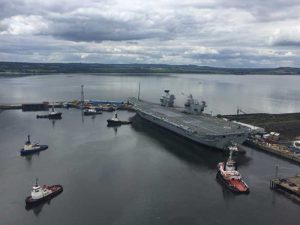
VIDEO: U.K.’s largest ever warship starts sea trials
JUNE 26, 2017 — HMS Queen Elizabeth, the U.K. Royal Navy’s first QE Class aircraft carrier, set sail from BAE System’s Rosyth shipyard today to commence first stage sea trials off the

JUNE 26, 2017 — HMS Queen Elizabeth, the U.K. Royal Navy’s first QE Class aircraft carrier, set sail from BAE System’s Rosyth shipyard today to commence first stage sea trials off the
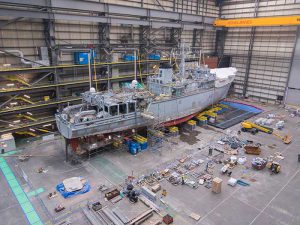
JUNE 19, 2017 — BAE Systems reports that a U.K. Royal Navy minesweeper, HMS Brocklesby, has begun her sea trials program, a significant milestone in her overaul period, four months earlier than
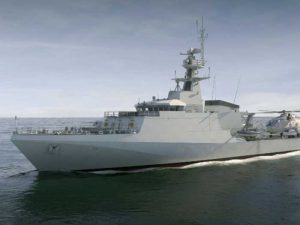
JANUARY 19, 2017 — The five River-class Offshore Patrol Vessels (OPVs) to be built by BAE Systems Naval Ships for the U.K. Royal Navy will be equipped with Integrated Platform Management Systems
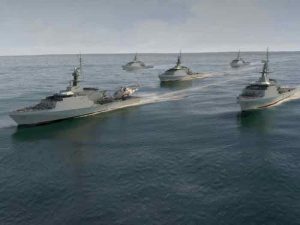
DECEMBER 10, 2016 — BAE Systems welcomed U.K. Minister for Defence Procurement Harriet Baldwin to its Govan shipyard in Glasgow, Scotland, December 8, to announce a £287 million (about $361 million) contract
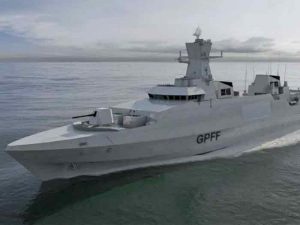
NOVEMBER 29, 2016 — The U.K. Government has now published an indepent report on naval shipbuilding undertaken by Sir John Parker, a British businessman who has chaired five FTSE 500 companies —
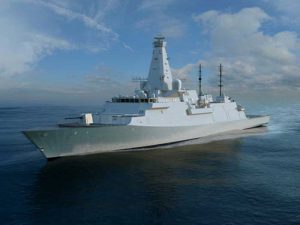
NOVEMBER 4, 2016 — BAE Systems says that the first steel will be cut on the Royal Navy’s Type 26 Global Combat Ships in Glasgow in summer 2017, subject to final contract
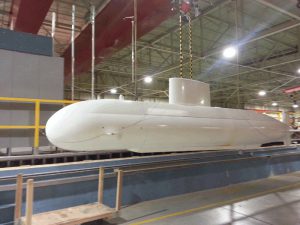
When it came time to upgrade the autopilot system in four Victoria-Class long-range patrol submarines, Canada’s Department of National Defence (DND) assembled a consortium including three federal government departments—National Research Council of Canada (NRC), DND, and Defence Research and Development Canada (DRDC)—and L-3 MAPPS of Montreal, the contractor that is supplying the control and simulation solutions for the new system. The builds of HMCS Victoria, Windsor, Chicoutimi, and Corner Brook began in the mid-1980s, so the original autopilot system has become obsolescent. The submarines are transitioning from point-to-point wiring to modern digital data bus communications.
The system includes an operator console, computers, and electronic enclosures. The computers receive data on depth, course, speed, pitch, roll, and heading from transducers, calculate, and send values to the rudder and hydroplanes’ control surfaces. When engaged, the new autopilot system will automatically adjust and compensate for any disturbance that could affect the submarine’s set course through the water, advises DND, either on the surface or when submerged. The autopilot system is independent from the ballast control system.
Built in the UK for the Royal Navy, the diesel-electric-driven submarines were bought by the Canadian government in 1998, after the Royal Navy decided to convert to an all-nuclear fleet. The first vessel slated for conversion to the new autopilot system is HMCS Windsor. She measures 70.3 meters long by 7.6 meters across the beam, and has a maximum operational depth greater than 200 meters. Displacement is 2,220 tons surfaced and 2,439 tons submerged, and maximum submerged speed is 20 knots.
David Millan, Senior Research Council Officer at the National Research Council of Canada in St. John’s, Newfoundland, has worked on the autopilot replacement project since 2012. The first order of business was to help develop the specifications for the autopilot control system. Then, on behalf of DND, he and his team evaluated three proposals for providing the simulation and control solutions. L-3 MAPPS was awarded the contract. Millan was aboard HMCS Victoria for 10 days off Halifax to collect full-scale baseline data on the existing autopilot system. When the new system is installed, the baseline data will be used to gauge its performance. Next, DRDC provided a numerical model which Millan and his team modernized, added an external interface, and used to provide an independent evaluation of L-3 MAPPS’ autopilot algorithm software. They then simulated the interaction between the numerical submarine and the numerical autopilot to commands such as “Do a turning circle”, “Hold a straight line”, and “Change depth”, and observed the movements of the simulated submarine. There were criteria for each maneuver such as accuracy in meeting the set point and course keeping. They also combined maneuvers, such as both changing depth and turning. They recommended improvements, which were quickly addressed by L-3 MAPPS. Millan notes that the new autopilot system has “a very snazzy interface” which emulates the old one, even though the technology has changed from push buttons to touch screens.
NRC’s tow tank which is 200 meters long by 12 meters wide by 7 meters deep—the largest in Canada—is used to test ships, marine components, assemblies, and software in varying current, wave, wind, and water conditions. Millan and his fabrication team spent five months building a model submarine for testing. It is 4.5 meters long by 6 meters, 1.1 meter from keel to top of sail, and weighs 670 kilograms. The model is comprised of: the nose assembly, containing the forward hydroplane system; the mid-body assembly, an aluminum pressure housing for the control and communication systems, support electronics, batteries, and sensors; the aft water-tight housing for the propulsion, rudder and aft hydroplane systems; the sail section for antennas and positioning systems; and a ballasted keel.
Dr. Jim Millan, NRC Director of Research and Development, explains that according to Froude scaling laws, the 1-to-15-scale model submarine they built measures 1/15th of the real submarine in each dimension. The model’s weight and propulsion power are 1/3375th of the actual submarine; the speed is one-quarter of the actual vessel, and events in model-scale time happen four times faster than at full scale (e.g., it can turn around in ¼ of the time). The model’s maximum submerged speed is 2.6 meters per second, and maximum power is 11 kilowatts.
In 2014, one week was spent in initial testing and commissioning, and a second week was spent conducting 14 operational tank tests in calm water, and also with seas coming from the bow and stern, with various wave heights, and with three different boat speeds. The tests included surfacing, diving, maintaining depth, and snorkel depth in various wave fields. The data from the physical model was used to improve the numerical model, which will be used in submariner training and also to generate data to assist operators.
Dr. Francois Belanger, Project Engineer for L-3 MAPPS, and DND project manager Hans Pall were involved in the model testing. The model submarine was operated wirelessly. The autopilot algorithm running on a PC on the shore controlled the hydroplanes on the model submarine. “For a PhD, Dr. Belanger is an immensely practical fellow,” observes David Millan. “He was able to change the autopilot on the fly to reflect the analysis of each run. I haven’t seen that done before: improving the algorithm while running the model.” He added that the DND project manager saw the model testing as an opportunity to advance the autopilot’s capabilities as much as possible before testing at full scale. Model testing also enabled them to acquire data on boat maneuverability and hydrodynamic characterization, information that was not transferred to DND when the submarines were acquired.
The old autopilot system’s use was captain-dependent, notes David Millan. The autopilot controlled the hydroplanes, but operational preferences determined whether or not the captain adjusted them manually. “Submarines around a certain speed, enter a transition zone going from maintaining depth in one mode to another mode,” explains Millan. “As you go faster, the hydroplanes move in opposite directions” (compared to moving in the same direction when moving slower), which is why the helmsman may choose to manually take control. The intelligent algorithm in the new autopilot system allows for adaptability, depending on the speed and performance of the vessel. It should be able to feel the boat and how it’s performing—to the extent that a machine can—says Millan, and change control modes as required. “It’s hard to do that with the old-fashioned hard-wired system,” he adds. “I hope it will be used in all of the cases where it’s operationally applicable. It will reduce the load on the helmsman.”
Reflecting on the importance of ensuring the numerical model is accurate, Dr. Jim Millan says, “That data potentially becomes a life and death decision-making tool. Knowing the capabilities of your submarine and being informed of its maneuverability and ability to escape or avoid harm, that’s what it’s all about. That’s what we do for the Navy. It’s safety and performance.”
Factory acceptance testing of the new autopilot equipment sets is complete. Ten days of sea trials are planned for October 2016 to complete characterization of the Windsor before the new equipment set is installed in early 2017. Sea acceptance tests are planned for spring 2017.
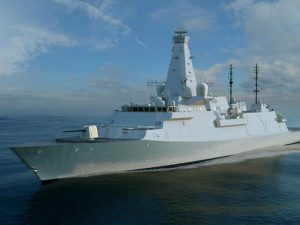
MAY 11, 2015 — BAE Systems has awarded an equipment contract to Rolls-Royce to manufacture diesel generators for the first three Type 26 anti-submarine warfare ships for the Royal Navy. This is

Notably, the buy of advanced Type 26 Global Combat Ships will be cut to eight ships from the previously announced 13.
The Type 36 ships are intended to replace the Royal Navy’s current Type 23 frigates in their anti-submarine role and the cuts to the program aren’t going down well in Scottish shipbuilding circles.
Overall, though, the plan adds to the number of ships in the fleet.
“We will maintain our fleet of 19 frigates and destroyers,” says the review. “We will also launch a concept study and then design and build a new class of lighter, flexible general purpose frigates so that by the 2030s we can further increase the total number of frigates and destroyers. These general purpose frigates are also likely to offer increased export potential. We will buy two further new offshore patrol vessels, increasing the Royal Navy’s ability to defend U.K. interests at home and abroad.”
The two new Queen Elizabeth Class aircraft carriers, the largest warships ever built for the Royal Navy, that will enter service from 2018, will also get added punch with an increase the number of F35 Lightning aircraft being bought. And one of the two carriers will be enhanced to support the amphibious capabilities of Royal Marines 3 Commando Brigade.
Three new logistic ships will be built to support the fleet, in addition to four tankers that will enter service from 2016.
BALLISTIC MISSILE SUBS WILL COST MORE
Not too surprisingly, Britain’s 20 year plan to replace the Vanguard Class of nuclear-armed submarines with a new class of four submarines, currently known as Successor, is starting to look a lot more expensive, going up from a previously estimated ›£25 billion to £31 billion, with a further £10 billion being budgeted for contingency.”The revised cost and schedule reflect the greater understanding we now have about the detailed design of the submarines and their manufacture,” says the review.
Download the National Security Strategy and Strategic Defense and Security Review HERE
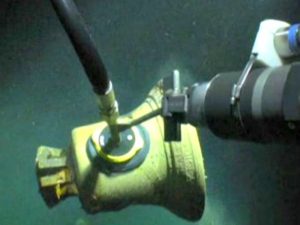
AUGUST 11, 2015—A research team led by U.S. philanthropist and entrepreneur Paul G. Allen successfully recovered the bell of the battlecruiser HMS Hood on August 7 in the Denmark Strait. The HMS Hood was sunk in